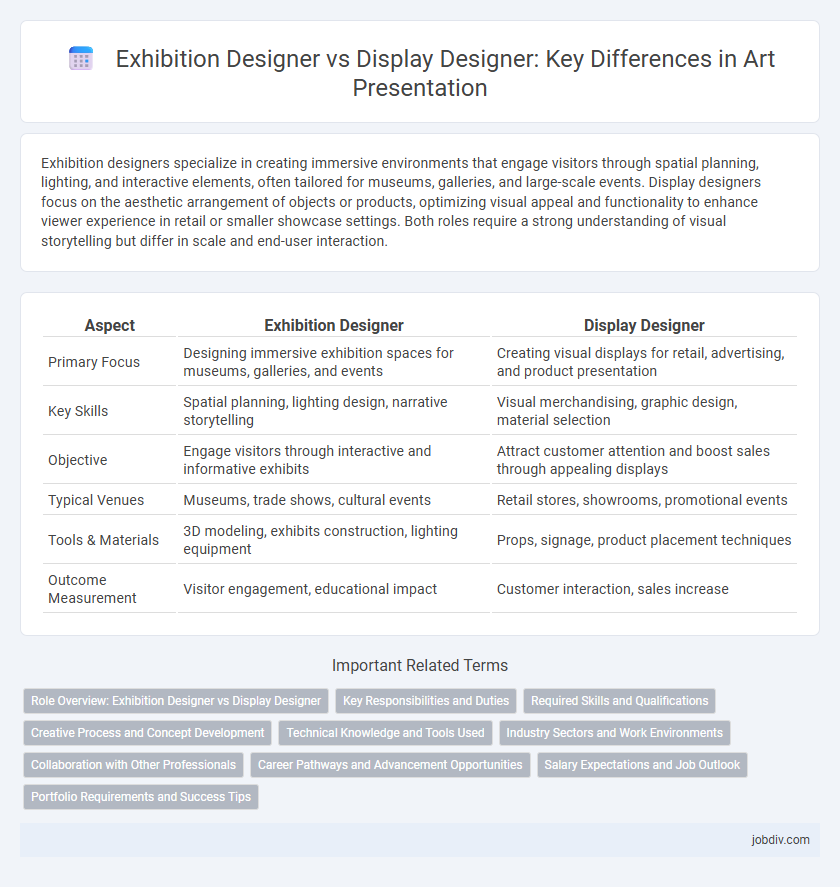Exhibition designers specialize in creating immersive environments that engage visitors through spatial planning, lighting, and interactive elements, often tailored for museums, galleries, and large-scale events. Display designers focus on the aesthetic arrangement of objects or products, optimizing visual appeal and functionality to enhance viewer experience in retail or smaller showcase settings. Both roles require a strong understanding of visual storytelling but differ in scale and end-user interaction.
Table of Comparison
| Aspect | Exhibition Designer | Display Designer |
|---|---|---|
| Primary Focus | Designing immersive exhibition spaces for museums, galleries, and events | Creating visual displays for retail, advertising, and product presentation |
| Key Skills | Spatial planning, lighting design, narrative storytelling | Visual merchandising, graphic design, material selection |
| Objective | Engage visitors through interactive and informative exhibits | Attract customer attention and boost sales through appealing displays |
| Typical Venues | Museums, trade shows, cultural events | Retail stores, showrooms, promotional events |
| Tools & Materials | 3D modeling, exhibits construction, lighting equipment | Props, signage, product placement techniques |
| Outcome Measurement | Visitor engagement, educational impact | Customer interaction, sales increase |
Role Overview: Exhibition Designer vs Display Designer
Exhibition Designers specialize in creating immersive, cohesive environments that narrate a story or theme through spatial design, lighting, and multimedia integration, primarily for museums, galleries, and trade shows. Display Designers focus on crafting visually appealing and strategically arranged layouts often for retail spaces, showcases, or product presentations to enhance consumer interaction and drive sales. Both roles require a strong understanding of visual aesthetics and user experience, but Exhibition Designers emphasize thematic storytelling while Display Designers prioritize product visibility and marketing impact.
Key Responsibilities and Duties
Exhibition designers focus on creating immersive spatial experiences by planning layouts, selecting materials, and integrating multimedia elements to communicate a cohesive narrative. Display designers specialize in crafting visually appealing displays, emphasizing product arrangement, lighting, and signage to attract and engage viewers within retail or gallery environments. Both roles require collaboration with artists, curators, and marketing teams to align design concepts with audience engagement and brand objectives.
Required Skills and Qualifications
Exhibition designers must possess strong spatial awareness, proficiency in 3D modeling software such as AutoCAD and SketchUp, along with a deep understanding of storytelling and visitor flow to create immersive environments. Display designers require expertise in visual merchandising, graphic design software like Adobe Creative Suite, and a solid grasp of brand identity to craft compelling product presentations. Both roles demand excellent communication skills, creativity, and the ability to collaborate with clients and multidisciplinary teams to ensure cohesive and engaging displays.
Creative Process and Concept Development
Exhibition designers focus on crafting immersive environments that guide visitor experience through spatial storytelling, integrating architecture, lighting, and multimedia elements to create cohesive narratives. Display designers concentrate on the meticulous arrangement of individual objects, optimizing visual hierarchy, and material selection to highlight artifacts within a given space. Both roles require deep collaboration in concept development, balancing aesthetic vision with practical constraints to evoke emotional engagement and communicate thematic messages.
Technical Knowledge and Tools Used
Exhibition designers specialize in creating immersive spatial environments, using software like AutoCAD, SketchUp, and 3D modeling tools to plan layouts, lighting, and visitor flow. Display designers focus on product placement and visual merchandising, often utilizing Adobe Creative Suite, CAD programs, and physical prototyping to design eye-catching displays. Technical knowledge for exhibition designers includes architectural principles and multimedia integration, while display designers prioritize graphic design skills and material fabrication techniques.
Industry Sectors and Work Environments
Exhibition designers primarily work within museum, gallery, and cultural heritage sectors, creating immersive spatial narratives that enhance visitor engagement through large-scale installations and interactive displays. Display designers focus on retail, commercial, and trade show environments, emphasizing product presentation, branding, and consumer experience to drive sales and visual appeal. Both roles require strong collaboration with curators, marketers, and architects, but exhibition designers lean towards educational and experiential goals, while display designers prioritize commercial impact and visual merchandising.
Collaboration with Other Professionals
Exhibition designers closely collaborate with curators, architects, and lighting specialists to create immersive environments that enhance visitor experience and narrative flow. Display designers work alongside merchandisers, graphic designers, and retail planners to optimize product presentation and visual appeal in commercial spaces. Both roles require seamless teamwork with stakeholders to balance artistic vision and practical functionality.
Career Pathways and Advancement Opportunities
Exhibition designers specialize in creating immersive environments for museums, galleries, and trade shows, often advancing by mastering curatorial collaboration and spatial storytelling techniques. Display designers focus on crafting visually compelling retail or commercial product arrangements, with career growth linked to expertise in consumer behavior and brand aesthetics. Both careers benefit from proficiency in digital design tools and expanding portfolios to attract higher-profile projects and leadership roles.
Salary Expectations and Job Outlook
Exhibition designers typically earn between $50,000 and $80,000 annually, with job growth projected at 9% over the next decade due to rising demand for immersive museum and trade show environments. Display designers, focusing on retail and commercial spaces, have salary expectations ranging from $40,000 to $70,000, influenced by retail industry trends and seasonal demand fluctuations. Both careers require creativity and technical skills, but exhibition designers often see more stable growth related to cultural and educational institutions.
Portfolio Requirements and Success Tips
Exhibition designers must showcase a diverse portfolio featuring spatial layouts, 3D models, and interactive installations that emphasize visitor engagement and narrative flow, while display designers focus on detailed visuals, lighting techniques, and product arrangement to enhance aesthetic appeal and brand messaging. Portfolios for exhibition designers require documentation of large-scale projects and client collaboration, whereas display designers need close-up shots highlighting craftsmanship and material usage. Success tips include continuous skill refinement in software like AutoCAD and SketchUp for exhibition designers and mastering visual merchandising trends and materials for display designers.
Exhibition Designer vs Display Designer Infographic

 jobdiv.com
jobdiv.com